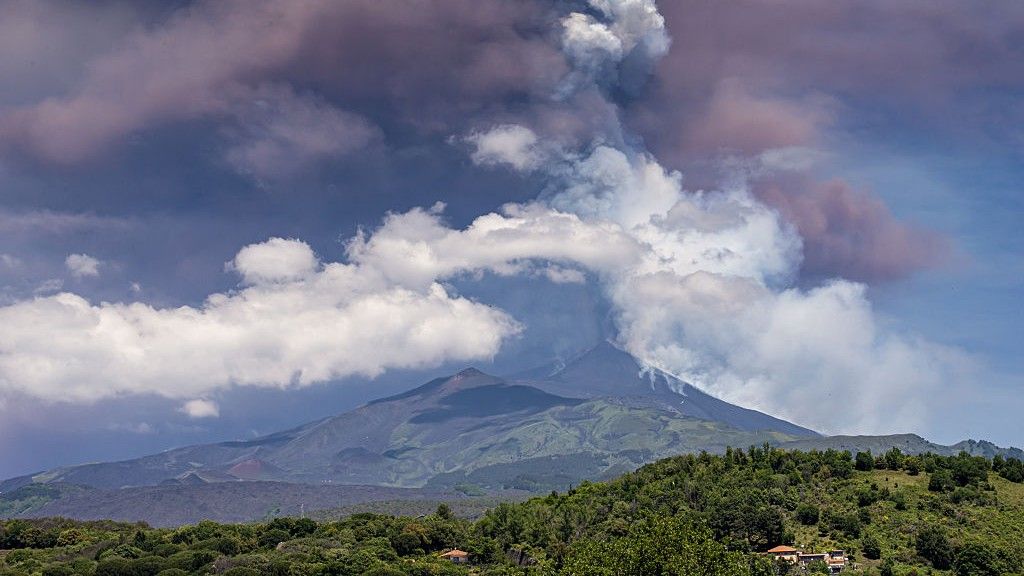A newly discovered way to monitor magma movements beneath Mount Etna could help scientists forecast when it might erupt.
Mount Etna, located on the Italian island of Sicily, is Europe’s largest active volcano. Humans have documented its activity for the past 2,700 years, but the volcano’s eruptive history stretches as far back as 500,000 years.
The novel method could make it easier to predict Mount Etna’s eruptions. In a new study, researchers at Italy’s National Institute of Geophysics and Volcanology (INGV) analyzed a parameter called the b value, which describes the ratio of low-magnitude to high-magnitude earthquakes in a region of Earth’s crust. This ratio can change as magma rises through the crust to the summit of a volcano, the researchers reported in a study published Oct. 8 in the journal Science Advances.
“Changes in the b value over time reflect how the stress inside the volcano is evolving,” study lead author Marco Firetto Carlino, a geophysicist at INGV’s Etna Observatory, told Live Science in an email. “Since magma ascent induces stress changes within the crust, tracking the b value can help reveal different stages of magma transfer from depth to the surface.”
The b value is an established parameter in volcanology, but the researchers examined it in a novel way, with an updated statistical model. By compiling 20 years’ worth of earthquake data from Mount Etna, they found a “very strong” correlation between the b value and Etna’s volcanic activity, Firetto Carlino said.
Mount Etna sits in the collision zone between the African and European tectonic plates. As a result, a vertical fracture in Earth’s crust known as a strike-slip fault underlies the volcano, thus facilitating the rise of magma to the surface, according to the study.
The crust beneath Mount Etna is up to 19 miles (30 km) thick. Magma rises through this volume before an eruption, but instead of replenishing a single magma chamber, the molten rock feeds a series of interconnected storage zones that are embedded in the crust at different depths.
The deepest magma storage zone is 7 miles (11 km) below sea level, Firetto Carlino explained, and it feeds an intermediate storage system with different zones likely extending 2 to 4 miles (3 to 7 km) deep. As magma rises, it travels through an intricate network of fractures and eventually reaches the last storage zone, which is located above sea level inside the volcano edifice.
The researchers had a wealth of data to work with and extract b values from, due to Etna’s frequent activity. They analyzed seismic patterns in the 19 miles of crust beneath the volcano from 2005 to 2024, paying particular attention to how these patterns varied between crustal regions.
Generally, regions of Earth’s crust with active magma storage zones show higher b values than more stable regions do, because the active zones experience more small earthquakes than bigger ones.
“This happens because rocks affected by moving magma become weak and highly fractured,” Firetto Carlino said. “For example, when magma inside a storage releases volatiles, they permeate the surrounding rocks, making it easier for small fractures to slip.”
Conversely, regions of Earth’s crust that are more stable typically experience more big earthquakes than smaller ones, because it takes more force to break the rock. “Rocks with good mechanical properties can store stress for longer periods,” Firetto Carlino said. “When they finally break, they produce larger earthquakes, corresponding to lower b values.”
So, by tracking the b value over time, it may be possible for researchers to follow the movement of magma through the deep crust to the first storage zone, up from there to the intermediate storage system, and up again to the shallow storage zone. This method could help experts estimate the timings of eruptions at Mount Etna.
“Monitoring the b value offers a powerful way to track magma movement within the crust and assess the volcano’s evolving state before eruptions,” Firetto Carlino said.
Mount Etna was a good test for the study due to its layered magma storage zones and enormous seismic catalog, but the results might also apply elsewhere.
“In principle, the b value could also be used to track magma movements in other volcanic areas, provided that a sufficient number of earthquakes is available and that their locations are distributed across different crustal sectors, well constrained by previous geological studies,” Firetto Carlino said.

